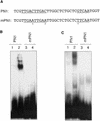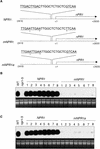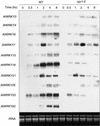Evidence for an important role of WRKY DNA binding proteins in the regulation of NPR1 gene expression
- PMID: 11449049
- PMCID: PMC139550
- DOI: 10.1105/tpc.010115
Evidence for an important role of WRKY DNA binding proteins in the regulation of NPR1 gene expression
Abstract
The Arabidopsis NPR1 gene is a positive regulator of inducible plant disease resistance. Expression of NPR1 is induced by pathogen infection or treatment with defense-inducing compounds such as salicylic acid (SA). Transgenic plants overexpressing NPR1 exhibit enhanced resistance to a broad spectrum of microbial pathogens, whereas plants underexpressing the gene are more susceptible to pathogen infection. These results suggest that regulation of NPR1 gene expression is important for the activation of plant defense responses. In the present study, we report the identification of W-box sequences in the promoter region of the NPR1 gene that are recognized specifically by SA-induced WRKY DNA binding proteins from Arabidopsis. Mutations in these W-box sequences abolished their recognition by WRKY DNA binding proteins, rendered the promoter unable to activate a downstream reporter gene, and compromised the ability of NPR1 to complement npr1 mutants for SA-induced defense gene expression and disease resistance. These results provide strong evidence that certain WRKY genes act upstream of NPR1 and positively regulate its expression during the activation of plant defense responses. Consistent with this model, we found that SA-induced expression of a number of WRKY genes was independent of NPR1.
Figures








References
-
- Bechtold, N., and Pelletier, G. (1998). In planta Agrobacterium-mediated transformation of adult Arabidopsis thaliana plants by vacuum infiltration. Methods Mol. Biol. 82, 259–266. - PubMed
-
- Borg, C., Lam, S.C., Dieter, J.P., Lim, C.T., Komiotis, D., Venton, D.L., and Le Breton, G.C. (1993). Anti-peptide antibodies against the human blood platelet thromboxane A2/prostaglandin H2 receptor: Production, purification and characterization. Biochem. Pharmacol. 45, 2071–2078. - PubMed
-
- Cao, H., Glazebrook, J., Clarke, J.D., Volko, S., and Dong, X. (1997). The Arabidopsis NPR1 gene that controls systemic acquired resistance encodes a novel protein containing ankyrin repeats. Cell 88, 57–63. - PubMed
Publication types
MeSH terms
Substances
LinkOut - more resources
Full Text Sources
Other Literature Sources
Molecular Biology Databases
Miscellaneous

